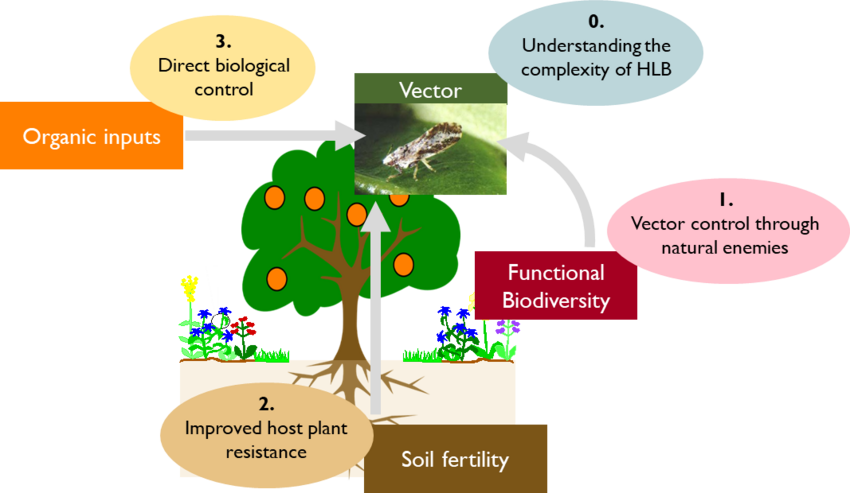The Citrus Greening Disease
Limitations in fighting the disease
Three species of Candidatus liberibacter bacteria cause citrus greening (HLB): Ca. L. asiaticus, Ca. L. africanus, and Ca. L. americanus, whereby the Asian form is the most widespread and dangerous. In conventional citrus production, the primary strategy has been to use chemical pesticides to fight the transmitting psyllids (D. citri) in combination with high application of fertilisers to boost productivity. Yet, this strategy has largely failed since, first, these chemicals also eliminate critical natural enemies of the vector D. citri, and, second, the vector tends to develop resistance towards chemical compounds used. Another strategy relates to gene-editing techniques intending to develop new HLB-resistant varieties. Nevertheless, these efforts will not be able to eliminate the disease in the short run. Also, the most used practice aiming to fight back the disease by removing infected trees is not leading to satisfactory results. Because HLB is systemic and has an incubation period of three months to multiple years before symptoms are visible, this measure is not successful enough to reduce the spreading of the disease in due time.
Worldwide relevance of the disease
Citrus Greening is the most important citrus plant disease worldwide. Originating from China, it is also known as Huanglongbing (HLB), which means "yellow shoot" in Chinese. The disease is caused by the bacterium Candidatus liberibacter, transmitted from plant to plant mainly by psyllids, especially Diaphorina citri. The bacterium attacks the tree’s phloem – the vascular tissue that transports nutrients – such that infected trees don’t grow at the rate of healthy ones, and their canopies become increasingly sparse. Although they appear healthy initially, HLB infected trees produce less fruit over time, which are also deformed with uneven colouration, aborted seeds, and a sour flavour. As infected trees become unproductive after a few years, the ultimate measure is to eliminate infected trees or complete orchards, implying huge losses for producers and the industry.
Despite the big efforts to fight the disease in conventional production – using mainly chemical pesticides to control the vector, the transmitting psyllids – HLB is still spreading at a global scale (see Figure 1). Economic losses are most meaningful for regions with widespread orange production: in China, where the disease originated, top-producing Jiangxi Province has lost 25% of its groves by the end of 2018; in Brazil, the disease has eliminated 52.6 million orange trees, leading to a 31% reduction in the area since 2004; in the U.S., the HLB disease has caused a billion dollar damage in Florida alone, as almost 90% of all orange trees are affected by this disease. Also, important production areas in California are affected. The disease has not yet reached Europe – but this must be expected given the fast expansion of the disease worldwide.
The ten most important orange producers & the global presence of the HLB disease in 2019
Challenges & approaches in organic citrus production
Organic standards don’t allow the use of chemicals and GMO techniques in fighting HLB. Only environmentally-friendly measures are allowed, which systematically help control the vector population with direct and indirect measures (see figure below) and strengthen citrus plants' resistance. The latter aims to reduce the impact of infection with production practices that help improve water and nutrient uptake by citrus trees.
Our research activities and findings relating to organic measures fighting the Greening Disease are documented in other sections of this website, under Our research and Resources.


 tap and then scroll down to the Add to Home Screen command.
tap and then scroll down to the Add to Home Screen command.